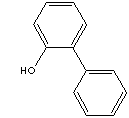PRODUCT IDENTIFICATION

H.S. CODE
TOXICITY
c1(c2c(cccc2)O)ccccc1
CLASSIFICATION
Disinfectants, Fungicide, Bactericide, Preservative; Germicide, bactericide, Anti-infective agent, Antiseptic, Biphenyl
EXTRA NOTES
PHYSICAL AND CHEMICAL PROPERTIES
282 C
1.293
SOLVENT SOLUBILITY
REFRACTIVE INDEX
530 C
123 C
Stable under ordinary conditions
EXTERNAL LINKS & GENERAL DESCRIPTION
http://www.dormer.ca/
What
is 2-Phenylphenol and where is it found: This chemical is used in
the manufacture of dyes and resins, rubber chemicals, fungicides,
germicides, preservatives and food packaging. It is used as a disinfectant
and fungicide for impregnation of fruit wrappers and seed boxes.
It can also be found in household disinfectants, some cosmetics,
cooling fluids and detergents. Further research may identify additional
product or industrial usages of this chemical.
http://www.bvsde.ops-oms.org/
2-Phenylphenol
(CAS No. 90-43-7) is used as a disinfectant, bactericide and virucide.
In agriculture, it is used in disinfecting fruits, vegetables and
eggs. It is also used as a general surface disinfectant in hospitals,
nursing homes, veterinary hospitals, poultry farms, dairy farms,
commercial laundries, barbershops and food processing plants. 2-Phenylphenol
is readily degraded in surface waters, with a half-life of about
1 week in river water. 2-Phenylphenol has been determined to be
of low toxicity. Both 2-phenylphenol and its sodium salt are carcinogenic
in male rats, and 2-phenylphenol is carcinogenic in male mice. However,
urinary bladder tumours observed in male rats and liver tumours
observed in male mice exposed to 2-phenylphenol appear to be threshold
phenomena that are species- and sex-specific. JMPR has concluded
that 2-phenylphenol is unlikely to represent a carcinogenic risk
to humans. Although a working group convened by IARC has classified
2-phenylphenol, sodium salt, in Group 2B (possibly carcinogenic
to humans) and 2-phenylphenol in Group 3 (not classifiable as to
its carcinogenicity to humans), JMPR noted that the IARC classification
is based on hazard identification, not risk assessment, and is furthermore
limited to published literature, excluding unpublished studies on
toxicity and carcinogenicity. JMPR also concluded that there are
unresolved questions about the genotoxic potential of 2-phenylphenol.
Local: Phenylphenol is used in formulating biocides and preservatives. It can be used as a additive for food packaging materials, seed boxes and household goods as a disinfectant and fungicide. Phenylphenol is used to manufacture germicide, fungicide, rubber chemicals and dyes.
GENERAL DESCRIPTION OF BIPHENYL: Biphenyl (also called Diphenyl, but exactly one of two compounds. The other is o-phenylphenol, used to prevent the growth of moulds ) is an aromatic hydrocarbon; molecule structure is composed of two six-sided carbon rings connected at one carbon site on each ring. Pure biphenyl is a toxic colourless crystalline solid with a pleasant odour; melting point 70 C, boiling point 255 C, which gives plates or monoclinic prismatic crystals; it is insoluble in water but soluble in ordinary organic solvents. It is directly used in the preservation of citrus fruits as a fungistat in transportation containers. It is a raw material for polychlorinated diphenyls (PCB) in which chlorine replaces hydrogen in biphenyls. There are 209 chlorinated isomers of biphenyl theoretically. But PCBs are referred to the biphenyl compounds with one to ten chlorine substitutions. PCBs are used heat-transfer agents and as electric insulators that block the flow of electric current across in electrical equipments. They are known as environmental pollution materials which are accumulated in animal tissues and cause toxic effects including carcinogenesis. Biphenyl is used as an intermediate for the production of a wide range of organic compounds (e.g. emulsifiers, optical brighteners, crop protection products, plastics), as a heat transfer medium alone or with diphenyl ether in heating fluids, as a dyestuff carrier for textiles and copying paper and as a solvent in pharmaceutical production. Aminodiphenyls are used as rubber antioxidants and intermediates for the synthesis of organic compounds ( azo dyes and pharmaceuticals). Biphenyl derivatives are used as an intermediate for the synthesis of organic compounds including pharmaceuticals, antifungal agents, optical brightening agents and dyes. Biphenyl compounds also used in luminescence chemistry, spectrophotometric analysis, molecular chemistry, and as a stating material for organometallic-complexes.
APPEARANCE
ASSAY
99.0% min
MOISTURE
0.1% max
GHS
PICTOGRAMS


HAZARD STATEMENTS
H315: Causes skin irritation
H335: May cause respiratory
irritation
H319: Causes serious eye irritation\
H400:
Very toxic to aquatic life
PRECAUTIONARY STATEMENTS
P304 + P340: IF INHALED: Remove victim to fresh air and
keep at rest in a position comfortable for breathing
P261: Avoid
breathing dust/fume/gas/mist/vapors/spray
P273: Avoid release
to the environment
P302+ P352: IF ON SKIN: Wash with plenty
of soap and water
P280: Wear protective gloves/protective
clothing/eye protection/face protection
P305 + P351 + P338: IF
IN EYES: Rinse cautiously with water for several minutes. Remove
contact lenses, if present and easy to do. Continue rinsing
![]() Xi
Irritant
Xi
Irritant![]() N
Dangerous for the environment
N
Dangerous for the environment
RISK PHRASES
36/37/38: Irritating to eyes, respiratory system and skin.
50:
Very toxic to aquatic organisms.
SAFETY PHRASES
22: Do not breathe dust.
61: Avoid release to
the environment. Refer to special instructions / safety data sheets.